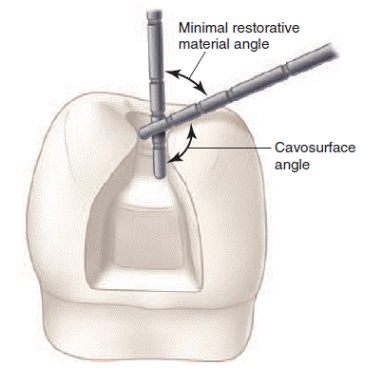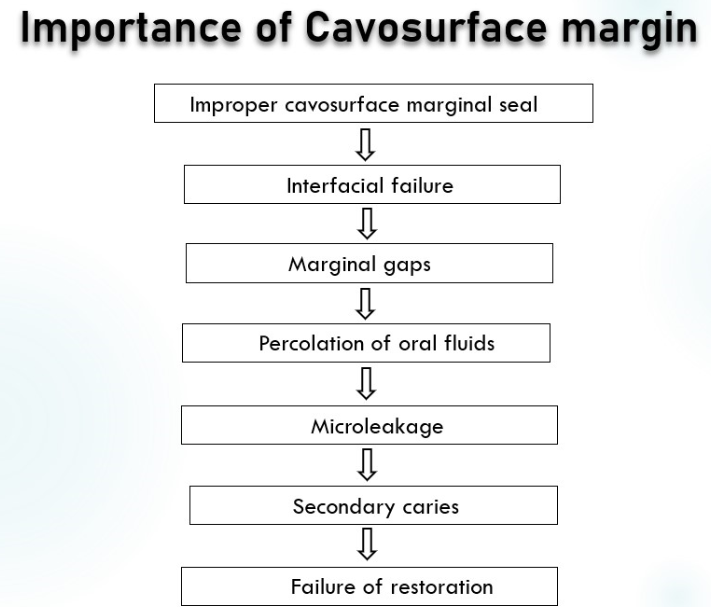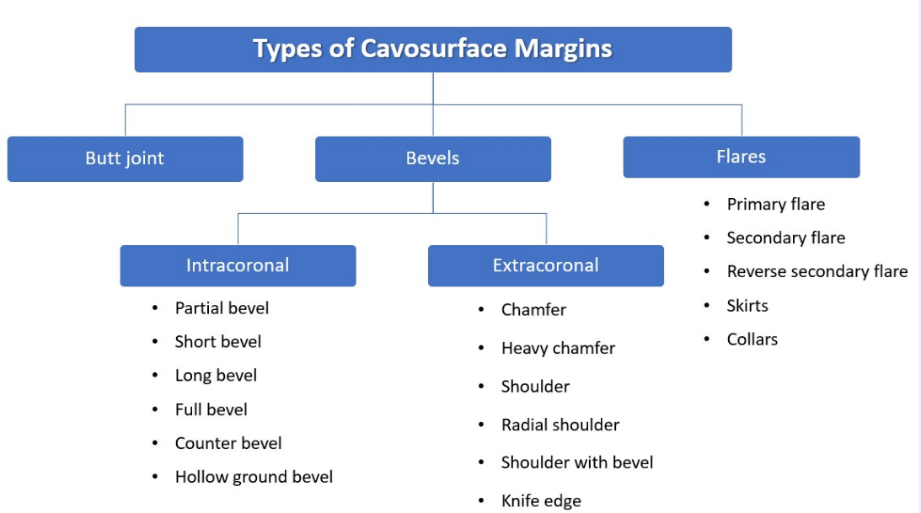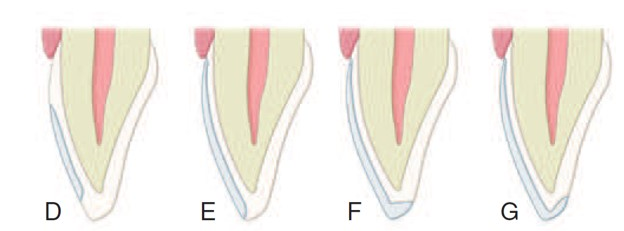- Visibility 465 Views
- Downloads 4 Downloads
- DOI 10.18231/j.ijce.2022.025
-
CrossMark
- Citation
Introduction
Many factors play a critical role in getting the best restoration, such as cavity design, operator skill, type of restorative material etc. However, the weakest link in any restoration is the tooth restoration interface. Every effort should be made to design and prepare these marginal peripheries to create the most favourable relationship with each other and for the longevity of the restoration. The restoration can survive in the biological environment of the oral cavity only if the margins are closely adapted to the cavosurface finish line of the preparation. One of the important aspects of cavity design is the cavosurface marginal seal/design.
Cavosurface Margin [1]
The cavosurface angle is the angle of tooth structure formed by the junction of a prepared wall and the external surface of the tooth.
The actual junction is referred to as the cavosurface margin.
The cavosurface angle may differ with the location of the tooth, the direction of the enamel rods on the prepared wall, or the type of restorative material to be used.
The cavosurface angle is depicted in [Figure 1].
Importance of Cavosurface margin
The importance of the cavosurface margin is depicted in [Figure 2].
Factors to be considered in preparing Cavosurface margin
Direction of enamel rods
Noy’s criteria
Type of restorative material
The location of margins
Direction of enamel rods:[1]
Theoretically, the enamel rods radiate from DEJ to the external surface of the enamel and are perpendicular to the tooth surface.
All rods extend full length from DEJ toward concave enamel surfaces and diverge outwardly towards the convex surface.
Noy’s criteria: [2]
Tooth preparation should rest on sound dentin.
Enamel rods of cavosurface angle should have their inner ends resting on sound dentin
Outer ends of enamel rods of cavosurface angle should rest on sound dentin with their outer ends to be covered with a restorative material.
Cavosurface angle should be properly trimmed or bevelled so as to prevent harm to tooth structure or restoration.
|
Designs of Margins for Cast Restorations |
||||
|
S.No |
Design of Margin |
Advantages |
Disadvantages |
Indications |
|
1. |
Full Shoulder |
Good edge strength due to more bulk |
Excessive tooth cutting |
Facial margin of metal ceramic and ceramic crowns |
|
2. |
Shoulder with bevel |
Good edge strength due to more bulk of material along with the advantages of bevel |
Involves excessive tooth cutting |
Facial margin of metal ceramic crown with supragingival margins |
|
3. |
Chamfer |
Easy to control extension clear cut margins with sufficient bulk Better finishing and polishing of margins |
More chances of unsupported enamel rods |
Cast metal restorations Margins of metal ceramic |
|
4. |
Bevel |
Less cutting of enamel Removal of unsupported enamel rods Better finishing of metal margins |
Apical margins have to be extended into gingival sulcus |
Margins of types I, II and III gold casting alloy restorations |
|
5. |
Chisel edge |
Conservative enamel cutting |
Indefinite and difficult to control location of the margins |
For malposed and tilted teeth Rarely used |
|
6. |
Feather edge |
Less cutting of enamel is required |
Poor strength due to inadequate bulk Difficult to control and finish the margins |
Must be avoided |






Types of Cavosurface Margins
Cavosurface margins are of three types ([Figure 3]):
Butt joint
90–100º cavosurface angle produces a butt joint.
Butt joint is usually given for brittle materials which have low edge strength.
Indications
Amalgam.
Glass ionomer restorations.
Direct Filling Gold restorations.
Bevels
A plane of a cavity wall or floor directed away from the cavity preparation.
Bevels are the flexible extensions of a cavity preparation allowing the inclusion of surface defects, supplement grooves or other areas of the tooth surface.
A cut that produces an angle of more than 90º with cavity wall.
Indications
The indications are depicted in[Figure 4].
Reverse Bevel:
It is given on the gingival seat. This bevel has three planes.
First – reverse bevel plane where the inclination is on the gingivoaxial plane, which prevents proximal displacement of the restoration.
Second - flat plane made of dentin.
Third - plane that is sloping away from the axial wall made up of enamel and dentin. This helps in preventing proximal displacement.
Bevels for Amalgam: [3]
Amalgam is a brittle material with low edge strength.
Sufficient bulk of the material gives good compressive strength.
Bevelled feather edge margins for amalgam - contraindicated.
If the margins are less than 80° - Tends to chip under occlusal stress
Cavosurface 90°- maximum strength for tooth and restoration.
For Amalgam class II restorations:[4]
Bevel contraindicated in occlusal cavosurface margins.
Butt joint Cavosurface angle 90 – 100°.
Marginal amalgam angle 80 - 90°.
Only exception for bevel is gingival cavosurface margins 15 – 20°.
A special instrument was designed to evaluate and obtain a cavosurface angle close to 110°. The design of the instrument also helps in evaluating parameters, such as depth of the cavity, undercut angle, and allows finishing of the buccal or lingual walls. [5]
Glass Ionomer restorations
For glass ionomer cement, prepare butt joint cavosurface margins since glass ionomer is a brittle material and, cannot be placed over the bevels.
Direct filling gold
Long and steep bevels and flares are contraindicated in direct gold restoration.
The cavosurface margins should be bevelled with a partial bevel.
This bevel is at 45° to the direction of enamel rods and should include at least ¼ of the enamel wall.
Junction between the bevel and dentinal wall should be rounded.[6]
Purpose of a bevel
Protects enamel wall from condensation energy.
Allow coverage of enamel wall by durable gold material.
To remove remaining rough enamel.
To create a 30-40° metal margin for ease in finishing the gold.
Class I
The external form of cavity for direct filling gold is quite similar to that of silver amalgam, except a very slight cavosurface bevel of 30-40° and 0.2 mm in width is placed on all margins using a smooth finishing bur or a flame-shaped whitestone.
Class II
Partial bevel on enamel only, not to include more than 1/4 of its extent.
Class III: [7], [8]
Ferrier design: A bevel is placed on all the enamel margins by wedelstedt chisel.
Loma Linda design: cavity preparation under this design is made with lingual access, indicated when esthetics is the major concern and in where the carious process involve the lingual marginal ridge and cavosurface is not beveled. Angle former or Wedelstedt chisel is used to give the bevel.
Ingraham design: This preparation design is indicated primarily for incipient proximal lesions in anterior teeth where esthetics is the main concern. After removal of diseased and undermined tooth structures, this preparation design will accommodate bulky gingival and incisal walls.
Class V
The most commonly followed class V cavity design is the Ferrier's design.
External outline is trapezoidal in form.
A slight occlusal cavosurface bevel is given using a wedelstedt chisel.
A bevel on the gingival wall is not given when the latter extends onto cementum.
Composite restorations
Three designs of cavity preparation for composite restorations may be used:
Conventional
Bevelled conventional
Modified preparation design
Cavity preparation for composite restorations
Conventional
Butt joint marginal configuration.
Used in areas when margins are located in non-enamel areas such as root surface.
Not a preferred cavity design.
Beveled Conventional Preparation:
Bevel is given on enamel margins.
The advantage of enamel bevel is that ends of the enamel rods (exposed by bevelling) are more effectively etched.
Bevel width – 0.25-0.5mm.
In class IV, bevel width is 0.25-2mm.
Class I Composite: No occlusal bevel
The interface between the composite restoration material and tooth structure showed maximum tensile stresses during simulated occlusal forces when tooth was prepared without the bevel. This could potentially lead to bond failure between resin composite and tooth structure. Whereas by using the bevel, the tensile stresses were eliminated in the tooth structure dental material interface. Apel Z et al. demonstrated the advantage of using bevel over no bevel during class I composite cavity preparation. [9]
Class II Composite
Gingival floor flat.
No bevel on gingival cavosurface margin.
Tooth preparation of a bevel is recommended for an optimal marginal seal in small box-type Class II composite restorations. [10], [11]
Cast restorations
Materials for cast dental restorations will be classified into the following:
Class I: Gold and platinum-based alloys – Type I, II, III, IV
Class II: Low gold alloy with gold content less than 50%
Class III: These are non-gold palladium-based alloys.
Class IV: Nickel chromium-based alloy.
Class V: Castable moldable ceramics.
For intracoronal preparations
The peripheral marginal anatomy of preparation is called a circumferential tie.
For intracoronal preparation, circumferential tie will be in form of bevel and flares.
Occlusal and gingivally – Bevels.
Vertical finish line proximally – Flares.
Occlusal cavosurface design
The cavosurface line angles of the preparation in the occlusal portion of the tooth should be finished with a bevel to avoid a right angle “butt joint”.
Depth of cavosurface bevel on occlusal margin should be approximately ¼ depth of respective wall.
This should result in 30-40° marginal metal on inlay which in turn results in a strong enamel margin with an angle of 140-150°.
The marginal metal will be too thin, weak and too difficult to burnish if the bevel produces an angle less than 30° of marginal bevel.
Purpose of occlusal bevel
Produces a stronger enamel margin.
Permits marginal seal in slightly undersized casting.
Provides marginal metal that is more easily burnished and adapted.
Reduces the amount of cement line that will be exposed to oral fluids.
Produces the bulk of metal on the edge of tooth structure which is helpful in waxing the pattern and finishing the casting to maintain the seal of restorations.
Gingival Cavosurface Seal:
The gingivo-cavosurface angle is also in the form of bevel. Usually, the angulation for gingival bevel is 30-40° which results in 30 ° gingival marginal metal, which is ideal.
The gingival bevel should be 0.5 – 1 mm wide and should be blend with lingual secondary flare.
If less than 30°, a thin and weak metal will be outcome.
Purpose of gingival bevels:
If the gingival margin is in enamel which is not bevelled, it will be weak because of the gingival declination of enamel rods.
The bevel results in 30°metal that is burnishable, because of its angular design.
A lap sliding fit - helps to improve fit of casting.
Variations in proximal marginal design
The design of proximal margins will depend on -
The extent of tooth tissue loss.
The location of that loss.
Tooth form, i.e. curvatures and embrasures.
The positional relationship with adjacent teeth.
The need for retention form.
Convenience form.
Box preparation
This is basically conventional technique.
Margins are prepared to permit a great bulk of wax which is consistent for subsequent finishing and adaptation.
The buccal and lingual proximal walls are finished in such a way so that cavosurface angle formed by proximal flare and tooth surface will be at right angle or slightly obtuse angles.
a) Primary flare
Is the conventional and basic part of circumferential tie facially and lingually for an intracoronal preparation.
It is very similar to a long bevel formed of enamel and part of dentin on the facial or lingual walls.
Primary flares always have a specific angulation ie., 45° to the inner dentinal wall proper.
Functions
Brings facial and lingual margins of the cavity preparation to self- cleansable, finishable area.
They will be the most peripheral part of the proximal preparation, if not a secondary flare must be placed peripheral to them.
b) Secondary Flare:
It is almost always a flat plane superimposed peripherally to a primary flare sometimes it is prepared in a hollow ground form to accommodate materials with low castability.
Secondary flare results in marginal metal of 40 degree.
Functions
Secondary flare of proximal walls extends the margins into embrasure making these margins more self-cleansing and more accessible to finishing procedure during the inlay insertion appointment.
The primary and secondary flare is depicted in [Figure 5].
Slice preparation
Placement of extracoronal taper using a disk of adequate diameter to contact nearly entire proximal surface.
It eliminates much of proximal anatomic undercut which facilitated taking an impression with a non-elastic impression material.
Slice is extended to cervical floor or slightly occlusal to cervical floor.
Placement of proximal slice produces excellent finish line.
Bevelling of proximal cavosurface with slice assures a sound enamel margin and yields a casting margin that is adapted and finished with relative use.
Auxillary slice
Slice preparation provides external support of weakened tooth or areas subjected to high stresses during function.
The auxillary slice partially wraps around the proximal line angles thus providing additional support.
An auxiliary slice around the lingual proximal line angle of a tooth will aid in preventing a buccal displacement of the casting.
Modified flare preparation
The modified flare is hybrid of the box and slice preparation.
Buccal and lingual proximal walls are initially formed with minimal extension, and then disked in a plane that only slightly reduces proximal wall dimension.
Extensive disking will reduce the retention of these walls.
The obtuseness of the cavosurface angle is enhanced.[12]
Porcelain inlay: Cavosurface marginal seal: [13]
Occlusal cavosurface marginal design should not be bevelled - it is difficult to fire porcelain to such a thin section which would also have the potential to fracture during seating.
All cavosurface margins should terminate in a butt joint.
Composite inlay: [14]
No benefit to placement of bevels at the occlusal or gingival margins, and bevels should-avoided because resin composite is susceptible to chipping at try in or cementations.
A 90° butt joints minimizes chipping problem but will result in a visible demarcation between the tooth and restoration.
Skirt preparations
Thin extensions of the facial or lingual proximal margins of the cast metal onlay that extend from the primary flare to a termination just past the transitional line angle of the tooth.
Skirts include facial and lingual surfaces at axial angles to a depth 0.5-1 mm in class – I and II alloys, and a depth of 1.5 – 2 mm for class III, IV and V cast materials.
Fine-grit diamond instrument is used for skirt preparation.
Collar preparation
To increase the retention and resistance forms when preparing a weakened tooth for a MOD onlay capping all cusps, a facial or lingual "collar," or both, may be provided.
Collar extensions: Axial depth of 1.5 mm- 2mm, and beveled shoulder finishing line gingivally.
271 bur is used for collar preparation.
Custom cast posts
Contrabevel is placed using flame shaped diamond point.
Bevel is placed at the junction of core and tooth structure.
Bevel - metal collar, prevents over seating & wedging effect of post.
Eliminates sharp angles and establishes smooth finish lines.
Veneers
Cross sections of the four types of veneers are depicted in Figure 6:
Root-end resections
Kacarska et al. conducted a study to assess the root resection bevels clinically and to estimate their relation to applied periapical surgeries.
Conventional periapical surgeries were performed with higher root bevel, with mean value of 46°and with ultrasonic technique with mean value of root resections of 20.7°.
Significantly lesser resection bevel associated with ultrasonic periapical surgery contributes to root preservation and favorable surgical outcome. [15]
Extracoronal preparations
The different extracoronal preparations for cast restorations are depicted in [Table 1].
Full metal crown preparations
Chamfer as finish line is used because it:
Provides bulk of metal needed for strength.
Allows good adaptation.
Metal ceramic crowns
Also called as PFM; It consist of ceramic layer bonded to thin cast metal coping.
Should be radial shoulder or shoulder with bevel 135°.
Shoulder because
Porcelain distorts less during firing.
Shoulder provides space for an internal site of metal to buttress the margins.
All ceramic crowns
Shoulder is prepared because :
It provides bulk for porcelain.
Provides that seal to resist forces direct from incisally.
For gold
Gingival finish is a fine chamfer or feather edge.
Porcelain onlays
Finish lines as hollow ground chamfer with no bevels.
The different bevels for extra coronal restorations are depicted.
Conclusion
The design and shape of margins of tooth preparation and restorations mainly depend upon properties of restorative material and the situation of the margin some materials require bevelling of the margins and some do not. Hence, thorough knowledge on the properties of restorative materials is required to place a long-lasting restoration.
Source of Funding
None.
Conflict of Interest
None.
References
- T M Roberson. Fundamentals in tooth preparation. Sturdevants's Art and Science of Operative Dentistry. 5th edn. 2006. [Google Scholar]
- N Garg, A Garg. Textbook of operative dentistry. 3rd edn.. 2010. [Google Scholar]
- MA Marzouk, AL Simonton, RD Gross, HJ Cargas. Class I cavity preparation for amalgam. Operative Dentistry Modern Theory and Practice. 1st Edn. 1985. [Google Scholar]
- R J Elderton. Cavosurface angle, amalgam margin angles and occlusal cavity preparation. Br Dent J 1984. [Google Scholar] [Crossref]
- A Arora, S R Acharya, V Ballal, P Sharma. A self-designed instrument to evaluate cavosurface angle for class I amalgam cavity preparation: A learning aid. J Conserv Dent 2012. [Google Scholar]
- L Baum. Gold foil (filling golds) in dental practice. Dent Clin North Am 1965. [Google Scholar] [Crossref]
- W I Ferrier. Treatment of proximal cavities in anterior teeth with gold foil. J Am Dent Assoc 1934. [Google Scholar] [Crossref]
- GD Stibbs. Direct golds in dental restorative therapy. 1980. [Google Scholar]
- Z Apel, B Vafaeian, D B Apel, A Hussain. Occlusal stresses in beveled versus non-beveled tooth preparation. Biomed Eng Adv 2021. [Google Scholar] [Crossref]
- NJ Opdam, JJ Roeters, R Kuijs, RC Burgersdijk. Necessity of bevels for box only Class II composite restorations. J Prosthet Dent 1998. [Google Scholar]
- FH Coelho-De-Souza, JC Camargo, T Beskow, MD Balestrin, CA Klein-Júnior, FF Demarco. A randomized double-blind clinical trial of posterior composite restorations with or without bevel: 1-year follow-up. J Appl Oral Sci 2012. [Google Scholar]
- GT Charbeneau, FA Peyton. Some effects of cavity instrumentation on the adaptation of gold castings and amalgam. J Prosthet Dent 1958. [Google Scholar]
- CD Hopp, MF Land. Considerations for ceramic inlays in posterior teeth: A review. Clin Cosmet Investig Dent 2013. [Google Scholar] [Crossref]
- T Bortolotto, I Onisor, I Krejci. Proximal direct composite restorations and chairside CAD/CAM inlays: marginal adaptation of a two-step self-etch adhesive with and without selective enamel conditioning. Clin Oral Investig 2007. [Google Scholar]
- M Kacarska. Clinical evaluation of root end resection bevel in periapical surgery. Prilozi 2017. [Google Scholar]
- Introduction
- Cavosurface Margin [1]
- Importance of Cavosurface margin
- Factors to be considered in preparing Cavosurface margin
- Types of Cavosurface Margins
- Butt joint
- Bevels
- Indications
- Reverse Bevel:
- Bevels for Amalgam: [3]
- Glass Ionomer restorations
- Direct filling gold
- Composite restorations
- Cast restorations
- For intracoronal preparations
- Variations in proximal marginal design
- Box preparation
- Slice preparation
- Auxillary slice
- Modified flare preparation
- Porcelain inlay: Cavosurface marginal seal: [13]
- Composite inlay: [14]
- Skirt preparations
- Collar preparation
- Custom cast posts
- Veneers
- Root-end resections
- Extracoronal preparations
- Conclusion
- Source of Funding
- Conflict of Interest
